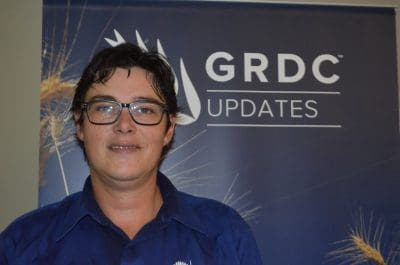A CHALLENGING 2017 growing season in the central west and Riverina regions of New South Wales gave researchers an opportunity to compare the yield outcomes of new barley varieties against proven performers over different time of sowing dates.

NSW DPI research agronomist David Burch compared the flowering dates and yield responses for 16 new varieties against the high-performing HindmarshA and La TrobeA in central western NSW.
A joint research investment by the NSW Department of Primary Industries (DPI) and the GRDC, the work was led by Condobolin-based NSW DPI research agronomist, David Burch.
Mr Burch said the flowering dates and yield responses for 16 new varieties were assessed against the high-performing HindmarshA and La TrobeA varieties over a range of sowing dates in central western NSW.
Lower than average winter rainfall and widespread frosts throughout much of NSW resulted in a 56 per cent drop in total barley production for 2017, compared to the previous record harvest in 2016.
Mr Burch said it was important for growers to be aware of the differences in a variety’s patterns of growth when making varietal and sowing decisions, in order to maximise yield.
“Early flowering varieties such as HindmarshA and La TrobeA have become popular due to their yield stability in medium to low rainfall cropping zones, but early flowering dates expose the crop to the risk of frost damage,” he said.
Trials at NSW DPI’s Condobolin Agricultural Research Station found that:
- The target flowering date for barley sown in central west NSW is the last week of August to the first week of September.
- La TrobeA and CompassA are responsive to nitrogen (N) fertiliser, provided sufficient rainfall occurs during the grain filling period.
- New barley varieties provide improved yield potential if there is adequate rainfall, however La TrobeA remains the yield benchmark in low yielding environments.
Condobolin received below average rainfall at the beginning of the growing season, and was impacted by 84 frosts throughout the flowering period, with 26 nights of temperatures below -2°C.
New barley varieties included AGTB0015, BiereA, BottlerA, ExplorerA, RGT PlanetA, and Spartacus CLA.
The highest yielding variety in all treatments was La TrobeA, while CompassA had equal or lower grain protein concentrations to La TrobeA.
There were significant effects observed between varieties and sowing dates. The May 12 (mid-season) sowing date had the greatest grain yield overall, with a mean yield of 1.68 tonnes/hectare in Condobolin.
Mid-May sowings yielded significantly greater than early and late sown treatments overall, although AGTB0015, BottlerA, IGB1305, RGT PlanetA and UrambieA all yielded significantly higher when sown on April 24.
All varieties with the exception of FathomA and RGT PlanetA incurred a yield penalty in the late sowing, compared to mid-season.
This experiment and those done in prior years indicate that in the central west of NSW, the target flowering date is the last week of August to the first week of September, in order to avoid frost induced yield losses and ensure sufficient soil moisture for grain fill.
Researchers also tested:
- Agronomic efficiency (kg grain yield per kg of N applied), finding that La TrobeA and CompassA were significantly more responsive to N fertiliser than GrangeRA and CommanderA.
- The performance of four high yielding varieties – La TrobeA , CompassA, Rosalind and RGT PlanetA – under different water treatments.
- The competitiveness of 18 barley varieties for their capacity to suppress or outcompete weeds.
Source: GRDC

HAVE YOUR SAY